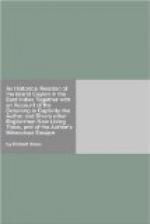[The Skin bears strings as strong as wyer.] It bears a leaf like to that of a Betel-Nut-Tree, which is fastned to a Skin as the Betel-Nut Leaves were, onely this Skin is hard and stubborn like a piece of Board: the Skin is all full of strings as strong as Wyer; they use them to make Ropes withal. As long as the Tree is growing the leaves shed; but when the Tree is come to its full growth, they remain many years upon the Tree before they fall; and when they fall, there are no new ones come again: The top-bud, as it ripens and withers, other buds come out lower and lower every Year till they come to the bottom of the Boughs, and then it hath done bearing, and so may stand seven or ten years, and then dyeth.
[The Wood; its Nature and Use.] The Wood of this Tree is not above three inches thick, mighty strong and hard to cut in two, but very apt to split from top to bottom; a very heavy wood, they make pestles of it to beat their Rice with; the colour black, but looks not like natural wood, but as if it were composed of divers pieces. The budds of this Tree, as also of the Coker, and Betel Nut-Tree, are excellent in tast, resembling Walnuts or Almonds.
[The Cinnamon Tree.] I proceed to the third Tree, which is the Cinnamon, in their Language Corunda-gauhah. It grows wild in the Woods as other Trees, and by them no more esteemed; It is most on the West side of the great River Mavela-gonga. It is much as plenty as Hazel in England in some places a great deal, in some little, and in some none at all. The Trees are not very great, but sizable. The Cinnamon is the [The Bark.] Bark or Rind, when it is on the Tree it looks whitish. They scrape it and pull it off and dry it in the Sun: they take it onely from off the smaller Trees, altho the Bark of the greater is as sweet to the smell and as strong to the tast. The [The Wood.] Wood has no smell, in colour white, and soft like Fir. Which for any use they cut down, favouring them no more than other wild Trees in the Wood. The [The Leaf.] Leaf much resembleth the Laurel both in colour and thickness; the difference is, whereas the Laurel hath but one strait rib throughout, whereon the green spreads it self on each sides, the Cinnamon hath three by which the Leaf stretches forth it self. When the young leaves come out they look purely red like scarlet: Break or bruise them, and they will smell more like Cloves than Cinnamon. It bears a [The Fruit.] Fruit, which is ripe in September, much like an Acorn, but smaller, it neither tasts nor smells much like the Bark, but being boyled in water, it will yield an Oyl swimming on the top, which when cold is as hard as tallow and as white; and smelleth excellently well. They use it for Oyntments for Aches and Pains, and to burn in Lamps to give light in their houses: but they make no Candles of it, neither are any Candles used by any but the King.
Here are many sorts of Trees that bear Berries to make Oyl of, both in the Woods and Gardens, but not eatable, but used only for their Lamps.




